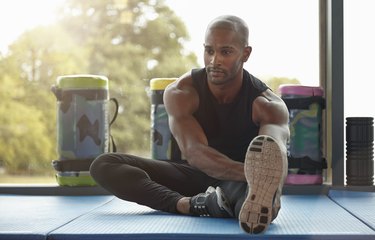
With enough practice, anyone is able to reach for their toes sitting down or bind their arm behind their back, but true flexibility has more to do with being able to move your muscles and joints through their complete range of motion than the P.E. class sit and reach.
By being able to move your joints through their complete range of motion, you can decrease your risk of injury and enhance your athletic performance, according to the Mayo Clinic. Everyone has varying degrees of flexibility, and one way you can improve yours is by incorporating more stretching into your routine.
That said, there are many different types of stretching, each with its own ideal time and place. Use this guide to the most common types of stretches to boost your own flexibility.
Static Stretching

When you were stretching in gym class or after track practice growing up, you likely did static stretching, aka passive stretching. In fact, when you think of stretching, it's probably what comes to mind.
In static stretching, you lengthen your muscles and other connective tissues and hold that lengthened position for a given amount of time, explains Grayson Wickham, PT, DPT, a physical therapist, certified strength and conditioning specialist (CSCS) and founder of the digital mobility platform Movement Vault. Basically, you stretch and relax in that position.
Though static stretching has long been common practice — and it can help improve your joint range of motion, per a January 2016 review in Applied Physiology, Nutrition, and Metabolism — it's not Wickham's go-to type of stretch for boosting flexibility.
Instead, he recommends passive stretching for activating the parasympathetic nervous system, which is associated with relaxation and recovery. In addition to the static stretching you do on your own, you can also do partner-assisted static stretching, in which you use a tool, like a strap, or a partner to help you stretch a muscle, Wickham says.
When to Use Static Stretching
Because of its relaxing effect, "static stretching is best used during a cooldown after a workout, along with deep breathing," Wickham says.
The only time you shouldn't use static stretching is before a workout because it has been shown to increase injury risk, Wickham says. In fact, a March 2013 review in the Scandinavian Journal of Medicine and Science in Sports suggests that static stretching can negatively affect muscular performance.
"I do not use static stretching in my program — or with the patients and athletes that I work with, unless they want to use it as a means to help them relax after a workout or on a rest day," Wickham says.
Try This Static Hamstring Stretch
- Sit on the floor with your legs extended straight out in front of you.
- Reach both of your arms forward as close to your toes as possible.
- Hold this position for at least 20 seconds and relax, allowing yourself to slowly reach your hands farther.
Active Stretching

Unlike static or passive stretching, active stretching involves lengthening your muscle and connective tissues, and then actively contracting the muscle you're stretching, Wickham explains. It's a bit of an umbrella term used to describe specific techniques, such as isometric and dynamic stretching.
If you're not sold on swapping out your old-school static stretching ways, though, know this: "Active stretching is an effective and time-efficient way to stretch with the goal of increasing flexibility and mobility," Wickham says.
So how does active stretching help you become more flexible, exactly? As you stretch, you begin to feel tension, a response your body launches to prevent injury when it thinks you are moving too far or too fast into a position, explains certified athletic trainer Austin Martinez, CSCS, ATC, director of education for Stretch Lab.
In order to become more flexible, though, you have to bypass this response — and the way to do so is to create contractions in the muscle you're stretching. This tricks your brain into relaxing the muscle, allowing you to stretch more deeply.
Although it sounds a little complicated, "you can turn any passive stretch into an active stretch by contracting the muscles you are stretching out," Wickham says.
If you really want to become more flexible, active stretching is the way to go. "With active stretching, you can make lasting mobility and flexibility changes in as little as 10 minutes per day," he explains. "Though there is a place for static stretching, most people need to actively stretch."
But when you should put active stretching to work depends on the exact method — isometric or dynamic — you're using.
Isometric Stretching

Isometric stretching is a form of active stretching, but you create a muscle contraction without movement, Martinez explains. Basically, after getting into a moderately stretched position (an intensity of six out of 10), you'll flex your muscle hard (an intensity of six or seven out of 10) for 10 to 15 seconds.
When to Use Isometric Stretching
"Isometric stretching is best used post-workout to help decrease soreness and recover range of motion," Martinez says. Just know that this method "is considered a more advanced type of stretching," Martinez says. "Therefore, if you're new to stretching or body work, this is not where I recommend you start."
Try This Partner-Assisted Isometric Hamstring Stretch
- Start lying on your back with a partner standing at your feet.
- Have your partner lift one leg up toward the ceiling, stretching the hamstring to a six out of 10 on the tension scale. This should be a deep — but not painful — stretch.
- Hold this position for 10 seconds.
- Then, push your heel into your partner's hands with strong effort (an intensity of six or seven out of 10) for 10 to 15 seconds.
- Relax and see if your partner can stretch your hamstring a little deeper, then repeat.
Proprioceptive Neuromuscular Facilitation (PNF)
Short for proprioceptive neuromuscular facilitation, PNF is generally considered a less intense form of isometric stretching, in which you contract your stretched muscle more gently and for a shorter duration of time, Martinez explains.
Because it supports flexibility, range of motion and muscle strengthening, it's a popular protocol in injury rehab.
When to Use PNF
If you're not quite ready for full-on isometric stretching, start with PNF. It's best used to support recovery and help prevent injury after workouts, Martinez says. An April 2012 review in Human Kinetics backs him up, finding that PNF works to maintain and increase range of motion.
In addition to its recovery and flexibility benefits, Martinez has found it can also help ward off muscle aches and even promote healthy posture.
Try This Partner-Assisted PNF Hamstring Stretch
- Lie face-up with your partner standing at your feet.
- Have your partner lift one leg up toward the ceiling, stretching the hamstring to a six out of 10 on the tension scale. This should be a deep — but not painful — stretch.
- Hold this position for 10 seconds.
- Then, push your heel into your partner's hands with gentle effort (an intensity of two out of 10) for just five seconds.
- Relax and see if your partner can stretch your hamstring a little deeper, then repeat.
Dynamic Stretching
While you activate your target muscle but keep your body still during isometric stretching and PNF, you get moving and stretching at once with dynamic stretching. "Think of dynamic stretching as actively moving your muscles and joints through their full range of motion without sustained passive holds," Wickham says. Basically, you stretch your muscles while you actually use them.
One major perk of this type of stretching is that, in addition to lengthening your tissues, it also promotes joint stability, which is essential for moving properly and avoiding pain and injury as you go about daily life and exercise, Wickham says.
It's even been shown to improve running and jumping performance in sports like basketball, according to a February 2012 review in the International Journal of Sports Physical Therapy.
When to Use Dynamic Stretching
Dynamic stretching is best for warming up before a workout because it gets your heart rate up, increases blood flow and revs up your muscles and joints for exercise. Doing a few dynamic stretches will also address any imbalances you have in range of motion. You can also use this time to foam roll tight muscles, helping them relax and lengthen.
Try This Dynamic Lunge Rotation Stretch
- Start in a half-kneeling position with your left leg forward and your right knee on the ground.
- Move your right knee as far back as possible, and then place your right hand opposite your left leg on the ground.
- Press the top of your right foot into the ground and straighten your right knee and leg.
- Extend your left arm straight out to the side as you push your right hand into the ground and rotate your chest up toward the ceiling as far as possible. Hold for five seconds.
- Next, rotate your chest to the opposite side, down toward your planted hand. Hold for five seconds.
- Repeat on the other side.
Related Reading
Ballistic Stretching
Though every method of stretching has a proper time and place, there is one method experts recommend avoiding altogether: ballistic stretching. With this approach, you essentially bounce in and out of a stretch.
"Think of it as pulling yourself in and out of the stretch rapidly, trying to push yourself past the limits of the muscle's length," Wickham explains.
The issue with ballistic stretching is that it's not only ineffective at increasing flexibility and mobility but it can also cause injury, Wickham says. The same February 2012 review in the International Journal of Sports Physical Therapy confirms this, stating that ballistic stretching is no longer recommended because of its link to injuries.
"I never advise ballistic stretching," he adds. "If someone's goal is to effectively increase flexibility and mobility and decrease injury risk, ballistic stretching has no place in their routine." So, if you're wondering when the best time to give this method a try is, well, there isn't one.